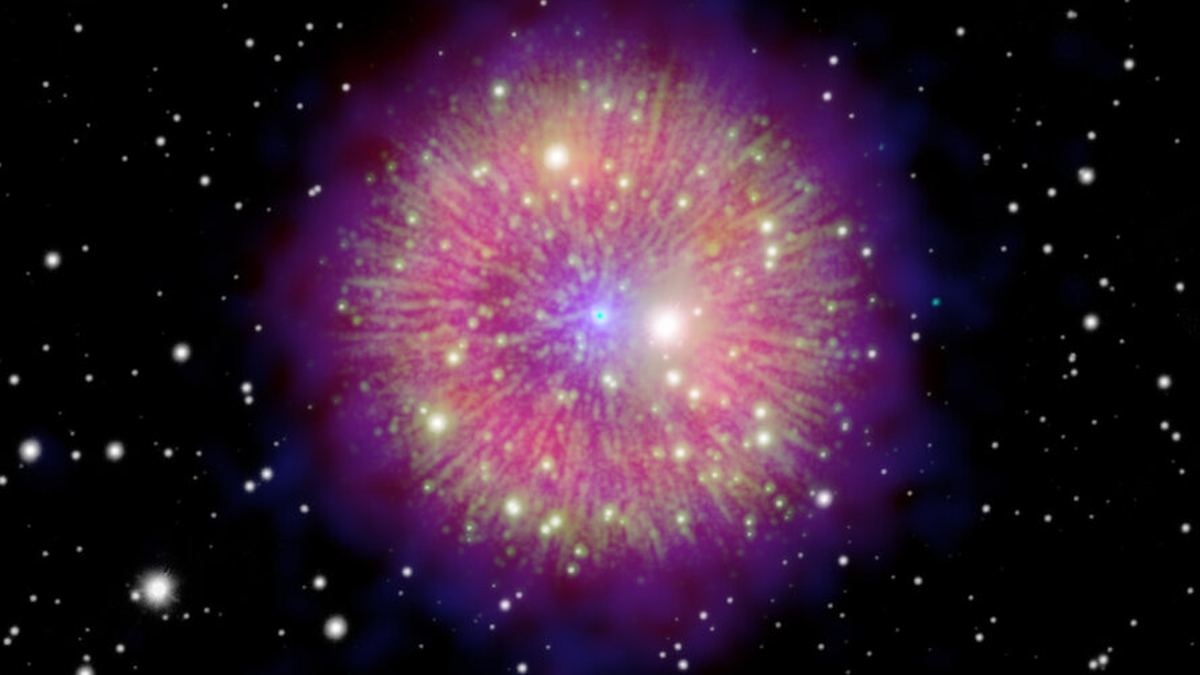

A composite image of the remnant of supernova 1181. A spherical bright nebula sits in the middle surrounded by a field of white dotted stars. Within the nebula several rays point out like fireworks from a central star. G. Ferrand and J. English (U. of Manitoba), NASA/Chandra/WISE, ESA/XMM, MDM/R.Fessen (Dartmouth College), Pan-STARRS
Historical astronomical records from China and Japan recorded a supernova explosion in the year 1181. It was in the constellation Cassiopeia and it shone as bright as the star Vega for 185 days. Modern astronomers took their cue from their long-gone counterparts and have been searching for its remnant.
But it took them time to find it because they were looking for the wrong thing.
When a massive star runs out of fuel, it collapses in on itself and then explodes. It leaves behind a dense core where the protons and electrons are crushed into neutrons. It’s called a neutron star, and they’re the smallest and densest stellar objects in the Universe other than black holes.
It took a concerted effort from astronomers over the years to understand SN 1181’s remnant. At first, they couldn’t even find it.
For a time, researchers thought that the pulsar 3C 58 was the remnant. The ancient Chinese and Japanese records were not accurate enough to pinpoint SN 1181’s exact location, and the pulsar was the only known supernova remnant in the area. However, as astronomers studied 3C 58, they determined that it was much too old to be the remnant.


In 2013, an American amateur astronomer discovered a nebula, now named Pa 30, near the region where the Japanese and Chinese saw it. It has an extremely blue central star, and now the name Pa 30 refers to both the star and the nebula.
Eventually, in 2018, French amateur astronomers working with an 8-inch telescope spotted a very hot blue star in the remnant’s center. It had a very odd spectrum, unlike stars in the centers of other remnants. Then, in 2019, astronomers published a paper showing that the nebula had a fierce stellar wind with a high velocity. This was strong evidence that what they were seeing was a supernova remnant.
But where was the neutron star? There was none, and in its place was a white dwarf. That means that astronomers were wrong about what type of supernova SN 1181 was.
SN 1181 wasn’t a core-collapse supernova, the type caused by a massive star that collapses in on itself and then explodes as it runs out of fuel. It was a Type Iax, a supernova created when two white dwarfs merge and explode. Those explosions typically leave no remnants, but in this case, it did. The Type Iax explosion was incomplete, and it’s responsible for the SN remnant’s unusual shape and the fact that the remnant isn’t a neutron star but a zombie star.
The leading image is a composite image of the Pa 30, the name given to the remnant and the star. The data for the image comes from multiple telescopes that capture different parts of the electromagnetic spectrum.
X-rays captured by the ESA’s XMM-Newton spacecraft are shown in blue, tracing the nebula’s full extent. NASA’s Chandra X-ray Observatory pinpointed the central source in the middle, the star named WD J005311. With a temperature greater than 220,000 Kelvin, it’s the hottest star known.
The remnant is almost invisible in optical light but is bright in infrared. NASA’s Wide-field Infrared Space Explorer (WISE) captured the infrared, shown in red and pink in the image. The nebula’s radial structure is interesting and has an unusual cause. The lines are heated sulphur glowing in visible light, captured by the ground-based Hiltner 2.4 m telescope at the MDM Observatory. The background stars were imaged with Pan-STARRS.
The ancient Japanese and Chinese who recorded the event had no real idea what they were seeing. They were more like court bureaucrats than astronomers, and they were steeped in astrology, not science. A member of the Japanese imperial court wrote that the supernova was “a sign of abnormality.” Another chronicler wrote that it was an “occasion for making auspicious offerings for a good harvest.”
But modern science shows us that it’s none of those things. Instead, it’s a wondrous object in the distant heavens, the result of forces and energies that the ancients had no idea existed. As a supernova, it forged heavy elements—especially the ones needed for life to appear—and spread them out into space. Its shock waves could’ve even triggered the birth of more stars as it slammed into the interstellar medium.
They couldn’t have known any of this, but from their perspective, they were right about one thing. As a Type Iax supernova that left behind a zombie star, SN 1181 was definitely a sign of abnormality.
NASA continues to progress with the development of the Nancy Grace Roman Space Telescope (RST),…
Our neighbour, the Large Magellanic Cloud (LMC), is rich in gas and dust and hosts…
New research on locomotion techniques that could be used in space exploration is constantly coming…
White dwarfs are the remnants of once brilliant main sequence stars like our Sun. They're…
We all know that asteroids are out there, that some of them come dangerously close…
It’s a familiar sight to see astronauts on board ISS on exercise equipment to minimise…